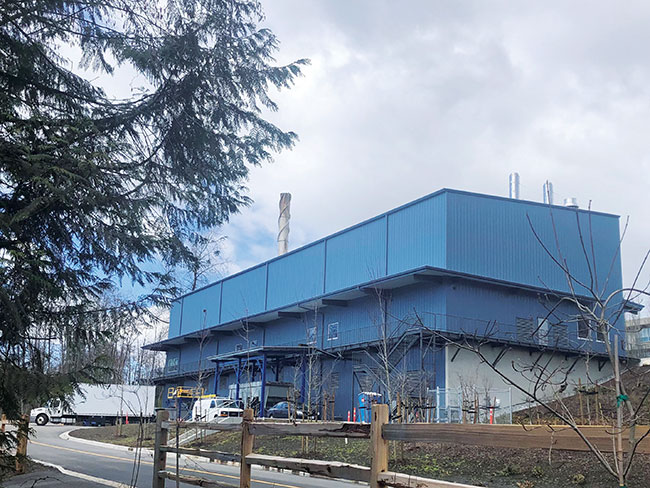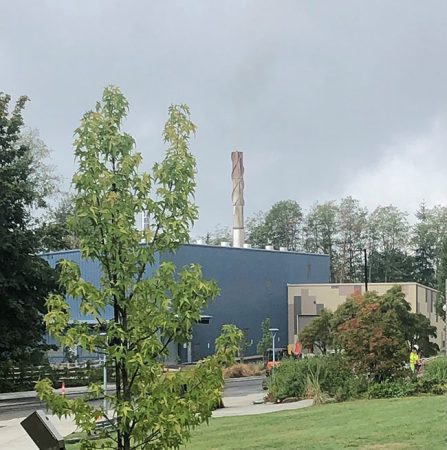
SFU’s new $33 million Corix biomass plant helps sustainably heat a community
November 25, 2021
By
Ellen Cools
 A view of the new $33 million Corix biomass plant providing heat and hot water to Simon Fraser University’s Burnaby, B.C., campus. Photos courtesy Simon Fraser University.
A view of the new $33 million Corix biomass plant providing heat and hot water to Simon Fraser University’s Burnaby, B.C., campus. Photos courtesy Simon Fraser University. Simon Fraser University (SFU)’s campus in Burnaby, B.C., is now home to a new $33 million biomass plant that is using urban wood waste to provide heating and hot water to the campus and a nearby residential community, UniverCity.
The biomass plant has been operating since October 2020, but the project has been eight-and-a-half-years in the making.
For SFU, the motivation behind switching from natural gas to biomass for heating and hot water was two-fold, explains Larry Waddell, SFU’s chief facilities officer.
“One, SFU had an aging traditional natural gas heating plant that served our campus. So, there was a desire to see what options we might have to replace or extend its life,” he explains. “There was also a desire to try to become more sustainable and respond to the province’s targets for the public sector to reduce greenhouse gas emissions.”
A unique partnership
At the same time, SFU’s independent real estate development group was developing a piece of land next to the campus into a private residential community, UniverCity.
The group that oversaw this project, the SFU Community Trust, wanted to make UniverCity a model sustainable community, and decided to implement a district energy system. They put out a Request for Proposal (RFP) looking for private utilities to invest in and build such a system, Waddell explains.
SFU also decided to participate in this process. Corix Utilities was the successful proponent of the RFP, coming up with the idea of a biomass heating facility that could serve both SFU and UniverCity. As a result, a unique partnership was born between SFU, UniverCity and Corix Utilities.
However, this set-up led to a few logistical challenges. SFU negotiated their own service contract directly with Corix, but since the biomass plant serves a private residential community as well, it has to be regulated by the B.C. Utilities Commission (BCUC).
“That’s what is somewhat unique about this – we do have a very specific contract that lays out the performance requirements of Corix, including how rates are determined,” Waddell says.
As part of the contract, Corix designed, planned and built the biomass plant, and now operates and finances it. They decided to install a Wellons biomass boiler inside a building designed and built by Wellons on SFU’s campus.
However, there was another logistical bump in the road.
“The City of Burnaby requires building permits to have an architect’s seal. As the building was designed by an engineering company, an architectural firm needed to be retained,” Waddell explains. “So, that was a challenge that Corix had to deal with.”
Inside the plant
Despite these difficulties, once construction began in 2019, things went fairly smoothly, notes Todd Gattinger, SFU’s director of maintenance operations. All told, construction took about 14-16 months.
As part of SFU’s contract with Corix, the utility secured a five-year fixed fibre supply contract with a five-year renewal clause for the university. The fibre for the plant is urban wood waste that would otherwise have gone to a landfill or another biomass facility.
“Our contract has very specific language regarding the type of material that can be used as fuel, including the requirement that timber can’t just be cut down and ground up for fuel,” Waddell says. “We won’t accept that.”
The plant itself connects to both SFU Burnaby campus’ existing natural gas plant and to UniverCity’s boilers through underground pipes. With a 13.5 MW capacity, 10 MW goes to SFU, with the remaining 3.5 MW directed to UniverCity.
To deliver that energy to their Burnaby campus, SFU made a small change to their natural gas plant, which had five Cleaver Brooks or Foster Wheeler boilers running in parallel: they removed the fourth boiler and replaced it with a heat exchanger. At one side of that heat exchanger is the biomass plant connected by half a kilometre of piping, and on the other side is SFU’s natural gas plant.
“Given this, from our standpoint, the biomass plant is essentially a new boiler,” Gattinger says.
The biomass plant now provides heating and hot water to 30 out of 50 buildings on SFU’s campus. The other four boilers are still running on natural gas, but they are only used to help meet heating and hot water demands during the colder months.

SFU expects the Corix biomass plant will reduce greenhouse gas emisisons from heating by 80 per cent.
Meeting expectations
Overall, SFU expects the biomass plant will reduce greenhouse gas emissions from heating by 80 per cent – the equivalent of emissions from 900 homes each year. According to Waddell, it puts SFU well on its way to achieving the B.C. government’s 2050 greenhouse gas targets.
At the time of writing, SFU planned to conduct an analysis of actual performance versus their business case in October, at the one-year mark of the biomass plant’s commissioning, to determine how well it’s working. That said, the Corix biomass plant is running as expected.
“Back in February, our natural gas expenditure at SFU’s Burnaby campus was one-third of what it would have normally been before we had the biomass plant,” Waddell shares. “That indicates it was clearly replacing a lot of our former natural gas-generated heat with biomass heat.”
“We have been tracking expenditures on a monthly basis to determine if they are in line with what we estimated as well as the levels of carbon emissions we projected to avoid. So far, this has been tracking exceptionally well, aligning closely to what we estimated in our business case,” Gattinger adds.
Community connections
The response from the local community and university students has been favourable, despite some initial reservations and misunderstandings about the sustainability of biomass.
“There’s been some confusion around why we’re burning wood and why that is better than clean burning natural gas,” Gattinger says. “The issue of wood being carbon neutral as opposed to natural gas is that urban wood waste would otherwise decompose and emit carbon into the atmosphere if not burned. Whereas natural gas left in the ground would not become a greenhouse gas.
The biomass facility also has a smoke stack where some smoke and steam can be seen coming out of it, which created some concern among students. However, the university has helped address those concerns by explaining how the system works and the regulations around emissions.
“In our case, Metro Vancouver is the authority that regulates emissions in this area, and the guidelines for emissions are some of the most stringent in the world,” Waddell explains. “This plant has to meet those requirements. We’ve set up monitoring stations on some of the adjacent buildings so we can keep track of that.”
Looking ahead, SFU doesn’t plan on expanding the biomass facility’s capacity, but does plan to reduce their energy requirements in other ways.
“We have a 55-year-old campus, so we have a lot of aging buildings – there’s an opportunity to explore ways to improve on that,” Gattinger says. “We’re now embarking on a district energy system modernization, which will see an upgrade of terminal units from a high temperature system to a low temperature one. The outcome will be that the percentage provided by biomass will reduce our overall heating needs.”
Ultimately, Waddell and Gattinger believe that switching to biomass heating is something that other universities and institutions can do fairly easily. Some, such as the University of British Columbia and the University of Northern British Columbia, have already done so.
“We would encourage other institutions to explore the viability of this type of biomss system for their campuses as well,” says Waddell. •
Print this page